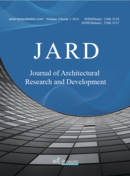The Development of the New Urbanism Theory and Reflections on its Application at Florida’s Seaside
Abstract
This article reviews the background, preparation, development and birth stage, and the main content and framework of the new urbanism theory, then understands new urbanism from a historical perspective and then discusses how the seaside project in Florida developed a smalltown community with a strong community atmosphere and a beautiful environment, guided by the theory of New Urbanism. This is followed by an in-depth analysis of the high construction and maintenance costs of New Urbanism in practice, the impact on the privacy of residents’ lives, the relative reduction of community ties, and other problems, and finally, it gives opinions on the sustainable development of the New Urbanism theory in the future.
References
McCann EJ, 1995, Neotraditional Developments: The Anatomy of a New Urban Form. Urban Geography, 16(3), 210-233.
Rusk D, 1993, Cities Without Suburbs.
Meredith JR, 2003, Sprawl and the new urbanist solution. Virginia Law Review, 447-503.
Burchell RW, Shad NA, et al., 1998, The Costs of Sprawl-Revisited, (No. Project H-10 FY’95).
Grant J, 2006, Planning the Good Community: New Urbanism in Theory and Practice, Taylor & Francis, 9.
Ferriter EK, 2008, The Sustainability of New Urbanism: Case Studies in Maryland. University of Delaware.
Walters D, Brown LL, 2004, Design first: Design-based planning for communities. Routledge.
Ewing R, Tian G, et al., 2019, Comparative Case Studies: Trip and Parking Generation at Orenco Station TOD, Portland Region and Station Park TAD, Salt Lake City Region. Cities, 87, 48-59.
Hamer D, 2000, Learning from the Past: Historic Districts and the New Urbanism in the United States. Planning Perspectives, 15(2), 107-122.
Bressi TW, 1994, Planning the American Dream. The New Urbanism: Toward an Architecture of Community.
Unwin R, 1913, Town Planning in Practice: An Introduction to the Art of Designing Cities and Suburbs. TF Unwin.
Langdon P, 1995, A Better Place to Live: Reshaping the American Suburb. Perennial. Marcuse, P. (2000). The New Urbanism: the Dangers so Far, DisP-The Planning Review, 36(140), 4-6.
Tu CC, Eppli MJ, 1999, Valuing New Urbanism: The Case of Kentlands. Real Estate Economics, 27(3), 425-451.
Frick D, Song Y, Knaap GJ, 2003, The Quality of Urban Life: Social, Psychological and Physical Conditions, New Urbanism and Housing Values: A Disaggregate Assessment. Journal of Urban Economics, 54(2), 218-238.
Bohl CC, 2000, New Urbanism and the City: Potential Applications and Implications for Distressed Inner?City Neighborhoods.
Rapoport A, 1986, The Use and Design of Open Spaces in Urban Neighborhoods.
Audirac I, Shermyen AH, 1994, An evaluation of neotraditional design’s social prescription: postmodern placebo or remedy for suburban malaise?. Journal of Planning Education and Research, 13(3), 161-173.

